Henry Webb, 1816 – 1866
by Brian Stevenson
last updated September, 2019
Henry Webb was
a well-regarded microscope slide maker during the 1850s and 60s. He presented at several international exhibitions, and was awarded at least one medal for the quality of his work. Webb was recommended as a slide supplier by one of the 19th century’s preeminent authorities on microscopy, Lionel Smith Beale. Despite all that, his work was largely forgotten for over 150 years. Brian Bracegirdle’s 1998 Microscopical Mounts and Mounters briefly mentioned Henry Webb, but did not specifically illustrate Webb’s work. Ironically, a slide made by Webb is illustrated in Microscopical Mounts and Mounters, but the maker was not recognized (plate 39, slide P). Henry Webb’s relative obscurity today may stem from his short career, which spanned no more than 15 years.
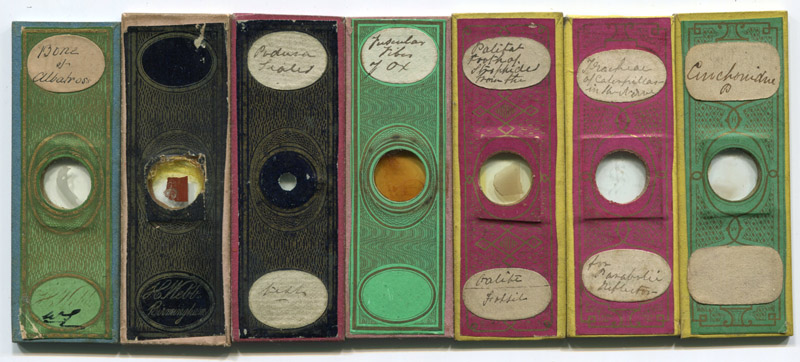
Figure 1.
Some slides by Henry Webb. Some custom papers contained printed “H. Webb” or “H. Webb Birmingham”, while other, essentially identical papers did not carry his printed name. Webb’s handwriting appears to have degenerated over time, perhaps an indication of the stresses that eventually led to his death. Left to right, four examples of a gold moiré pattern on green and black front papers (a version on red paper is also known), and three slides with custom patterns of gold on red or green paper, with the initials H and W embedded in the diamond pattern. Slides with the moiré patterns appear to be Webb’s earliest productions. Additional examples of Webb’s papers are shown in “Microscopical Mounts and Mounters,” plates 30-G and 39-P.
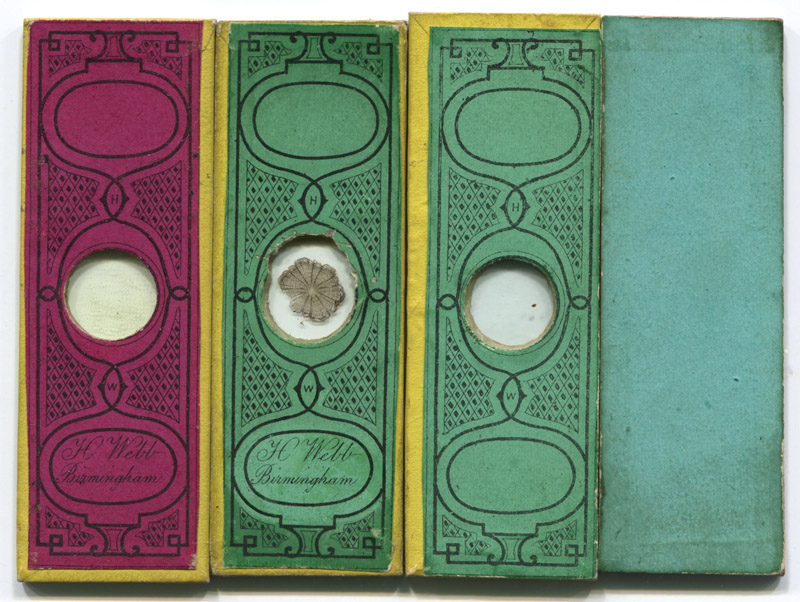
Figure 2.
Views of the backs of some Webb slides. He frequently applied a custom-printed paper to the reverse (left three slides). The slide on the right is one of Webb’s earlier preparations, which frequently carry plain, light blue paper on the reverse.
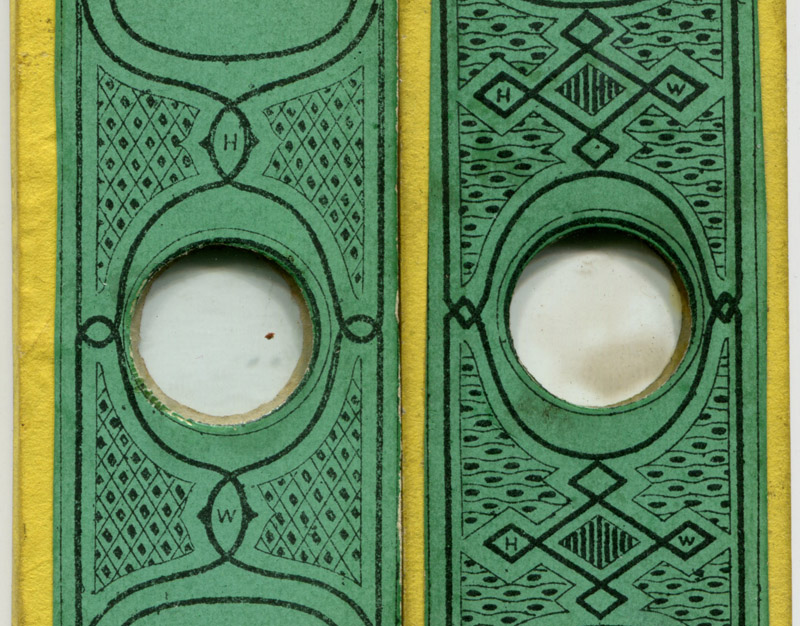
Figure 3.
Closeup views of the H and W initials embedded in Webb’s custom papers. William Porter, who evidently acquired Webb’s stock after his death, used these papers on many of his early slides (or pasted his own label onto Webb’s slides), but marked out Webb’s initials with ink (see this site’s essay on W. Porter for details).
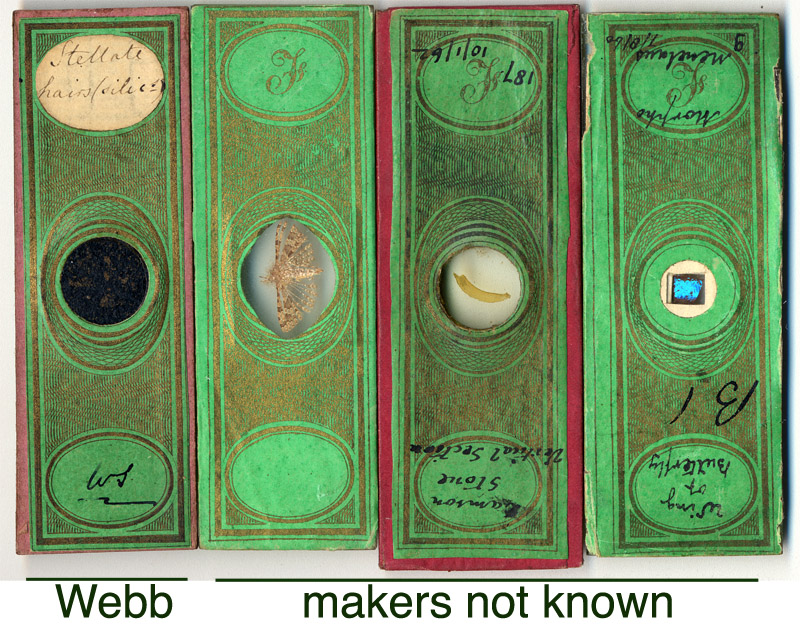
Figure 4.
The moiré pattern on some of Henry Webb’s slide papers is identical to the pattern found on slides that are often labeled with a single letter “F”. These “F” slides often have different handwritings on them, suggesting that the slides were made by different people. This raises a strong possibility that “F” was not a single slide maker, but instead was the supplier of the slide papers. For examples, papers with the initials “S B” were produced by microscope makers Smith and Beck, and papers with the initials “J A” were apparently sold by microscope maker J. Amadio. Noting that Webb lived near Birmingham, home of the microscope makers Field and Son, “F” may have stood for Field.
Henry Webb’s neighbor and apparent business successor, William Porter, occasionally used Webb’s papers on his own slides. On the specimens I have seen, Porter had crossed out Webb’s initials using an ink pen. Examples of Porter slides with Webb’s papers can be seen in the biography of William Porter, and in Microscopical Mounts and Mounters plate 30-G, where the paper was mid-identified as being by J.T. Norman.
Henry Webb was born in Bristol, Gloucestershire ca. 1816. He married Esther Harper in 1843 at St. Martin, Birmingham, Warwickshire. They had at least seven children, an average-sized family for that time. One daughter, Fanny, appears to have died before the age of 13, also a not-uncommon occurrence in those days.
The 1851 census reports that Henry worked as a gardener, the family living on Bristol Road, Edgbaston, Warwickshire. Later in life, Webb exhibited many botanical specimens at his scientific club, an interest possibly connected with his gardening experiences. Our Mr. Webb may be the man mentioned in the 1867 book Botany of Worcestershire, “I must remark, however, that an intelligent gardener of Birmingham, Mr. H. Webb, from whom I have received several rare mosses, and among them Tetraphis pellucida, from the Lickey, informed me that Osmunda regalis yet grows in an obscure place by a pool within Mr. Taylor's plantations at Moseley.”
The earliest known published information on Henry Webb’s involvement was published in 1856. The soiree of the British Medical Association included an exhibit by “Mr. Henry Webb of Birmingham, who is a most able microscopic injector, exhibited some beautiful preparations.” That description of Webb’s skill at injecting histological specimens with dyes and mounting slides implies that he had been seriously developing those talents for quite a while before 1856. Deep-mount histological slides, including a rarity with Webb’s diamond-etched signature, may date from this time period (Figures 5 and 6).
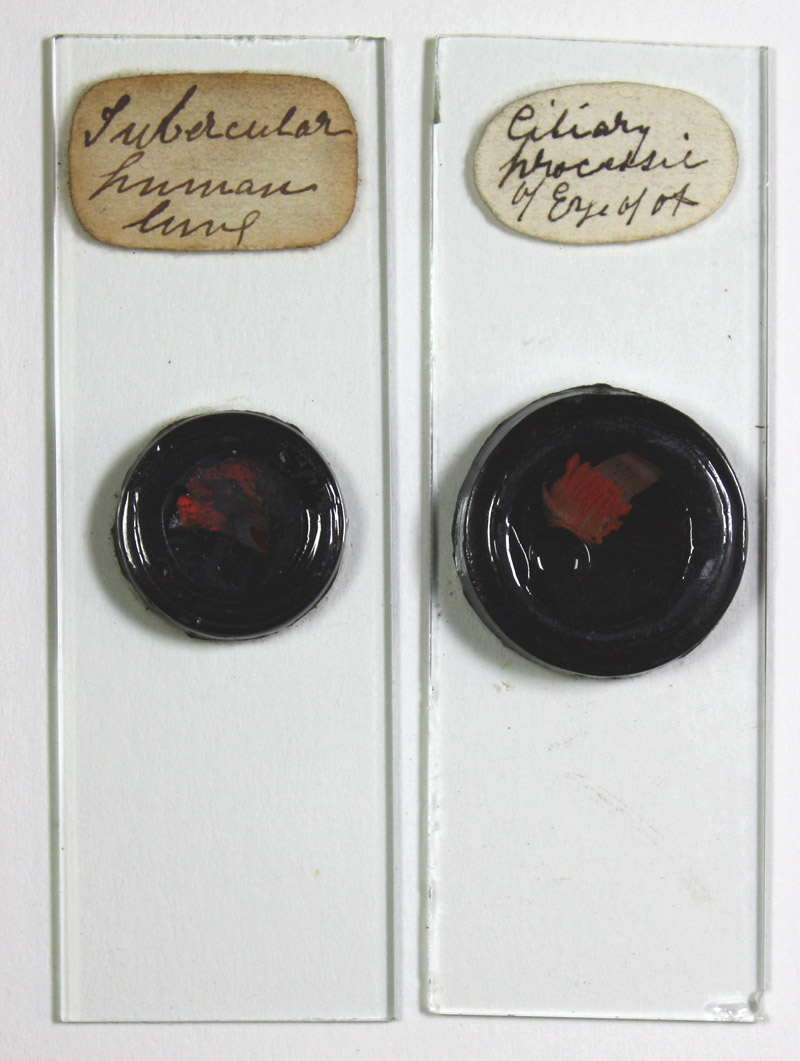
Figure 5.
Two dye-injected tissues, deep-mounted in preservative fluid. The handwriting is recognizeable as Henry Webb’s.
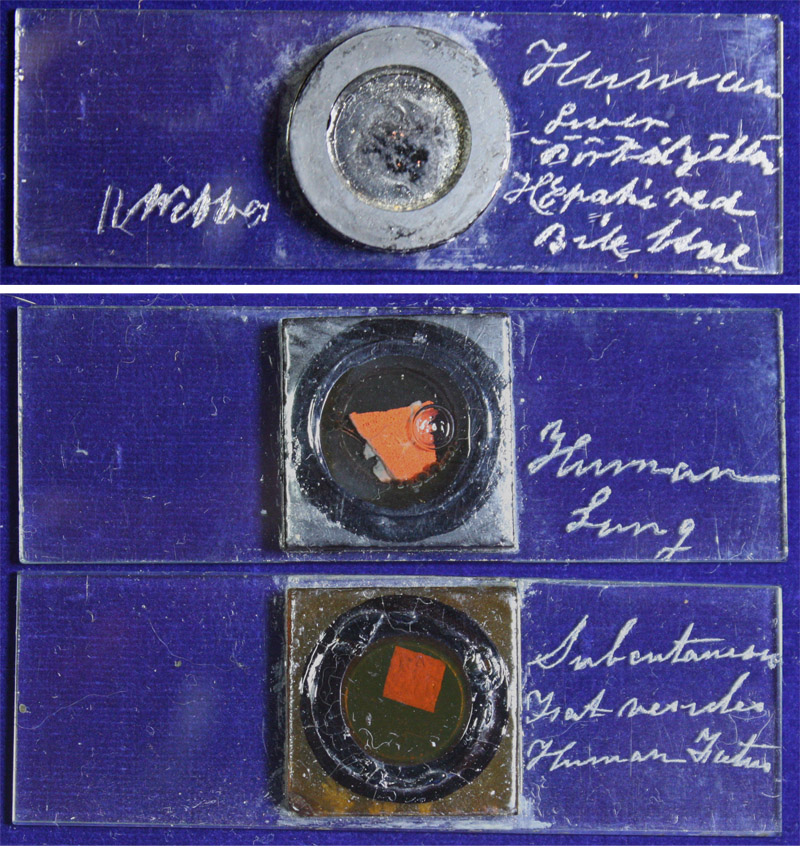
Figure 6.
The top slide is a deep-mount histological preparation, signed by Webb. Unfortunately, the specimen is missing. Nonetheless, this rare example of his etched signature along with handwriting is very useful for identifying his unsigned slides, such as the lower two.
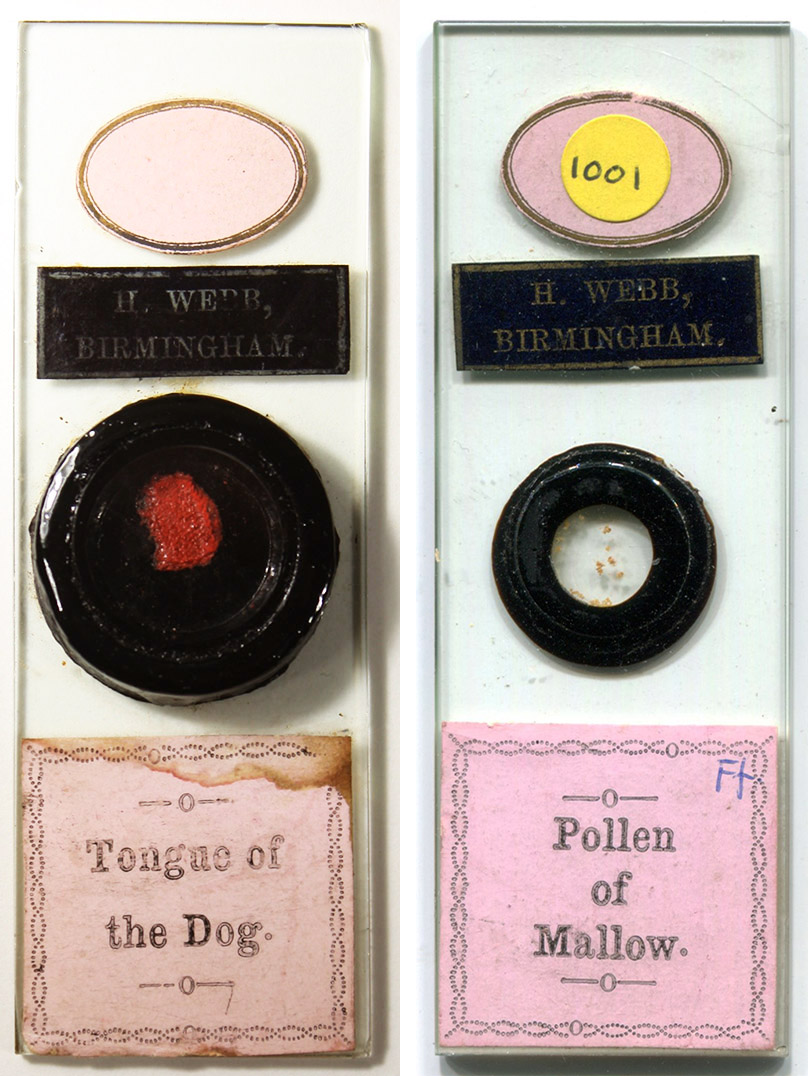
Figure 7.
Two preparations by Henry Webb, with simple, printed labels. A small label with gold printing on black paper gives Webb’s name and address. With the widespread distribution of commercially-prepared glass slips for use as microscope slides during the 1860s-70s, paper-wrapped slides fell out of vogue and simple labels such as these became popular (paper-wrapping was primarily functional: papers on the sides of slides covered the rough edges of the hand-cut glass). These slides probably date to near the time of Henry Webb’s death, i.e. circa 1866.
Prior to 1858, the Webbs moved to George Street, Balsall Heath, in the Kings Norton district of Worcestershire. Although now a part of Birmingham, Balsall Heath in the mid-1800s was in a separate county. Microscopy appears to have then been Webb’s primary occupation. He was recorded as being an “optician” and “preparer of microscopic objects” in an 1858 commercial directory of Birmingham and the surrounding areas. The 1861 census also listed him as such.
In 1862, Henry Webb exhibited at the International Exposition in London. He was awarded an Honourable Mention “for his skilful manufacture of microscopic objects.”
He also
exhibited at the 1865 Dublin International Exhibition. His presentations included “objects for the microscope ; freshwater
algae, &c. &c. ; injections, opaque and transparent.” A report on the exposition in Chemical News commented “H. Webb, of Birmingham, shows what appears
to be a very fine collection of microscopic objects, as far as an opinion can
be given without an examination under the instrument.”
Late that same
year, Lionel Smith Beale published his third edition of How to Work with the Microscope. An appendix recommended the following six Preparers of Microscopic Objects: John Barnett, Alexander Hett, Hudson and Son, John T. Norman, Charles M. Topping, and H. Webb. Beale clearly held Webb in good company.
William B. Turner named a species of desmid (an alga) Euastrum webbianum, in honor of Webb. In his original description of the species, Turner stated “to the memory of Henry Webb (a good and unassuming man, among mounters of his time facile princeps) I dedicate this species. I have Desmids and Algae mounted by him, in camphor-water, still sound and perfect, although the slides were prepared 40 years ago”.
In addition to
being a preparer of microscopic specimens, Henry Webb was actively involved in
the Birmingham Natural History and Microscopical Society. A diversity of interests was evident. On September 13, 1864, he exhibited “the luminous moss Schistostega pinnata”. During 1865, “specimens, both botanical,
mineral, and zoological, &c., were given by Mr. Henry Webb.” The following year,
“Mr. H. Webb read a highly practical and
interesting paper ‘On Blights.’ It
was most profusely illustrated by diagrams, specimens, and microscopical
preparations.” An 1877 report
of the Birmingham society described Webb as having been “prominent among the contributors.” That article also mentioned that Henry Webb “stood in the foremost rank as a preparer of
microscopic objects.”
Hardwicke’s
Science-Gossip reported from the 1867 Paris Exposition, which opened in April,
that “microscopic objects are exhibited
in the British section by Mr. Topping and Mr. Norman, of London, Mr. Cole, of
Liverpool, and Mr. Webb, of Birmingham.” That article implies that Webb’s preparations were
presented. It is unknown who
actually showed his material, or how it was presented, since Webb did not
attend.
Henry Webb died four months before the Paris Exposition opened, on 22 December, 1866. His death record states that he
committed “suicide by poisoning with
carbolic acid while insane.”
Acknowledgements
Many thanks to
Brian Davidson, Howard Lynk and Steven Gill for freely sharing information and
pictures of their slide collections.
Resources
Association Medical Journal (1856) The Soiree, New series, Vol. 4, page 684
Beale, Lionel Smith (1865) How
to Work with the Microscope, 3rd edition, published by Lindsay
& Blakiston, Philadelphia, page 263
Bracegirdle, Brian (1998) Microscopical
Mounts and Mounters, Quekett Microscopical Club, London, page 100 and plates 30-G and 39-P
Cook, Mordecai C. (1867) A Voice from Paris, Hardwicke’s Science-Gossip, vol. 3, May 1, pages 97-99
Death record for Henry Webb. Registered first quarter (1867)
Kings Norton, vol. 6c, page 273
Dublin International
Exhibition of Arts and Manufactures, Official Catalogue (1865) published by
J. Falconer, page 14.
England vital statistics, accessed through ancestry.co.uk
General and Commercial
Directory of the Borough of Birmingham, and six miles round (1858)
published by W. H. Dix & Co., pages 310 and 449. Accessed through http://www.historicaldirectories.org/hd
International Exhibition
1862, Official Catalogue, 3rd edition, published by Truscott Son
& Simmons. Entry 2987
Langford, John Alfred (1877) Modern Birmingham and Its Institutions, Vol. 2, page 47.
Lees, Edwin (1867) The Botany of Worcestershire, Worcestershire Naturalists’ Club, Worcester, page 120
Medals and Honourable
Mentions Awarded by the International Juries (1862) second edition,
published by Her Majesty's Commissioners by George Edward Eyre and William
Spottiswoode, page 202
Quarterly Journal of
Microscopical Science (1865) “Proceedings of Societies: Birmingham Natural
History and Microscopical Society”, Vol. 5, page 80
Quarterly Journal of
Microscopical Science (1866) “Proceedings of Societies: Birmingham Natural
History and Microscopical Society”, Vol. 6, pages 195-197
Tichborne, Charles R.C. (1865) “Dublin International
Exhibition”, Chemical News, Vol. 12, July 7, page 5
Transactions of the Microscopical Society of London (1864) “Proceedings of Societies: Birmingham Natural
History and Microscopical Society”, Vol. 12, pages 299-300
Turner, William B. (1893) Algae Aquae Dulcis Indiae Orientalis, The Freshwater Algae of East India, P.A. Norstredt and Sons, Stockholm, page 86






